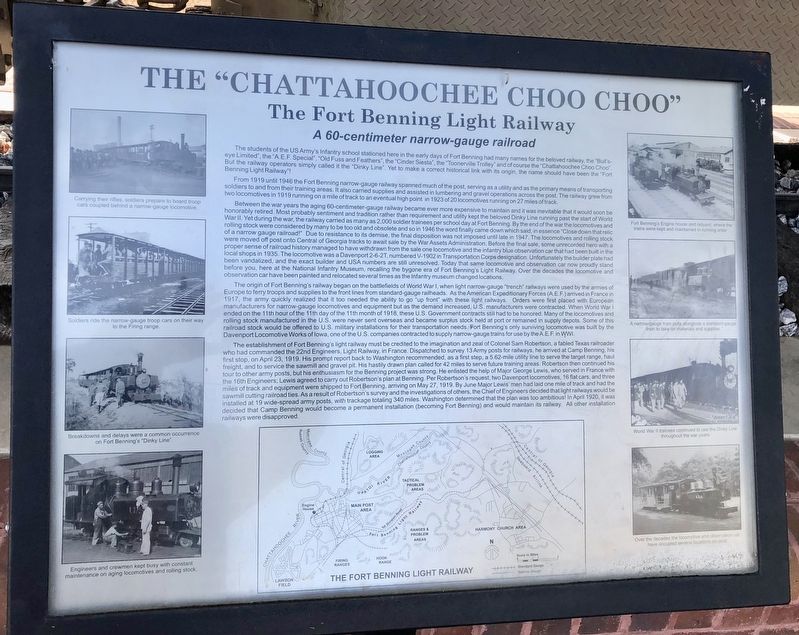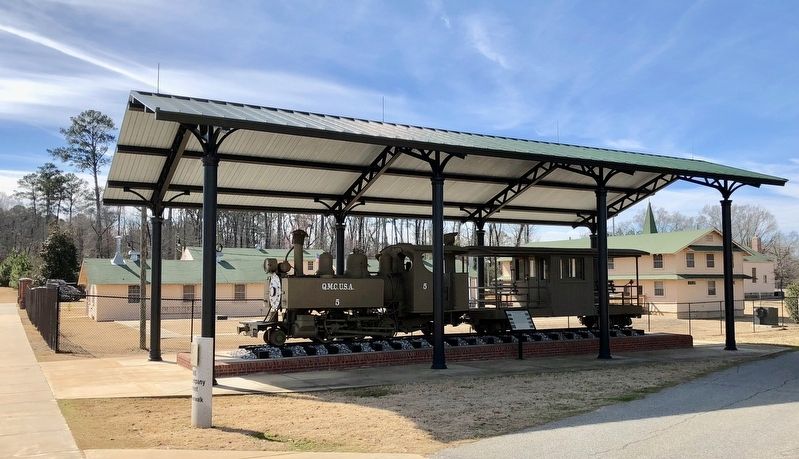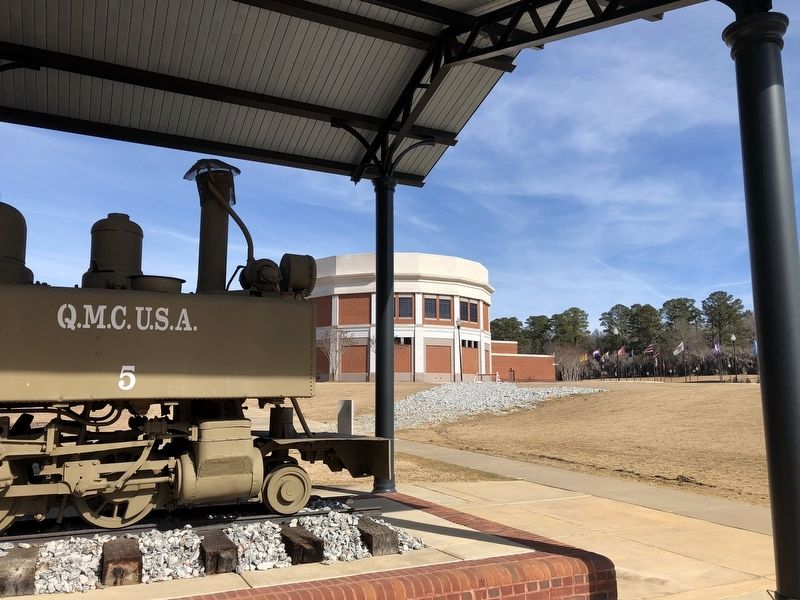Columbus in Muscogee County, Georgia — The American South (South Atlantic)
The "Chattahoochee Choo Choo"
The Fort Benning Light Railway
— A 60-centimeter narrow-gauge railroad —
From 1919 until 1946 the Fort Benning narrow-gauge railway spanned much of the post, serving as a utility and as the primary means of transporting soldiers to and from their training areas. It also carried supplies and assisted in lumbering and gravel operations across the post. The railway grew from two locomotives in 1919 running on a mile of track to an eventual high point in 1923 of 20 locomotives running on 27 miles of track.
Between the war years the aging 60-centimeter-gauge railway became ever more expensive to maintain and it was inevitable that it would soon be honorably retired. Most probably sentiment and tradition rather than requirement and utility kept the beloved Dinky Line running past the start of World War lI. Yet during the war, the railway carried as many as 2,000 soldier trainees per school day at Fort Benning. By the end of the war the locomotives and rolling stock were considered by many to be too old and obsolete and so in 1946 the word finally came down which said, in essence "Close down that relic of a narrow gauge railroad!" Due to resistance to its demise, the final disposition was not imposed until late in 1947. The locomotives and rolling stock were moved off post onto Central of Georgia tracks to await sale by the War Assets Administration. Before the final sale, some unrecorded hero with a proper sense of railroad history managed to have withdrawn from the sale one locomotive and the infantry blue observation car that had been built in the local shops in 1935. The locomotive was a Davenport 2-6-2T, numbered V-1902 in Transportation Corps designation. Unfortunately the builder plate had been vandalized, and the exact builder and USA numbers are still unresolved. Today that same locomotive and observation car now proudly stand before you, here at the National Infantry Museum, recalling the bygone era of Fort Benning's Light Railway. Over the decades the observation car have been painted and relocated several times as the Infantry museum changed locations.
The origin of Fort Benning's railway began on the battlefields of World War I, when light narrow-gauge "trench" railways were used by the armies of Europe to ferry troops and supplies to the front lines from standard-gauge railheads. As theAmerican Expeditionary Forces (A.E.F.) arrived in France in 1917, the army quickly realized that it too needed the ability to go "up front" with these light railways. Orders were first placed with European manufacturers for narrow-gauge locomotives and equipment but as the demand increased, U.S. manufacturers were contracted. When World War I ended on the 11th hour of the 11th day of the 11th month of 1918, these U.S. Government contracts still had to be honored. Many of the locomotives and rolling stock manufactured in the U.S. were never sent overseas and became surplus stock held at port or remained in supply depots. Some of this railroad stock would be offered to U.S. military installations for their transportation needs. Fort Benning's only surviving locomotive was built by the Davenport Locomotive Works of Iowa, one of the U.S. companies contracted to supply narrow-gauge trains for use by the A.E.F. in WWI.
The establishment of Fort Benning's light railway must be credited to the imagination and zeal of Colonel Sam Robertson, a fabled Texas railroader who had commanded the 22nd Engineers, Light Railway, in France. Dispatched to survey 13 Army posts for railways, he arrived at Camp Benning, his first stop, on April 23, 1919. His prompt report back to Washington recommended, as a first step, a 5.62-mile utility line to serve the target range, haul
freight, and to service the sawmill and gravel pit. His hastily drawn plan called for 42 miles to serve future training areas. Robertson then continued his tour to other army posts, but his enthusiasm for the Benning project was strong. He enlisted the help of Major George Lewis, who served in France with the 16th Engineers; Lewis agreed to carry out Robertson's plan at Benning. Per Robertson's request, two Davenport locomotives, 16 flat cars, and three miles of track and equipment were shipped to Fort Benning, arriving on May 27, 1919. By June Major Lewis' men had laid one mile of track and had the sawmill cutting railroad ties. As a result of Robertson's survey and the investigations of others, the Chief of Engineers decided that light railways would be installed at 19 wide-spread army posts, with trackage totaling 340 miles. Washington determined that the plan was too ambitious! In April 1920, it was decided that Camp Benning would become a permanent installation (becoming Fort Benning) and would maintain its railway. All other installation railways were disapproved.
Topics. This historical marker is listed in these topic lists: Railroads & Streetcars • War, World I • War, World II. A significant historical date for this entry is April 23, 1919.
Location. 32° 23.246′ N, 84° 57.342′ W. Marker is in Columbus, Georgia, in Muscogee County . Marker can be reached from Legacy Way east of South Lumpkin Road. Located behind the National Infantry Museum. Marker is at or near this postal address:. Touch for map. Marker is at or near this postal address: 1775 Legacy Way, Columbus GA 31903, United States of America. Touch for directions.
Other nearby markers. At least 8 other markers are within walking distance of this marker. Dedicated to the American Revolutionary War Infantryman (about 300 feet away, measured in a direct line); World Trade Center Beam Memorial (about 500 feet away); Specialist Ross A. McGinnis (about 700 feet away); The Infantryman (about 700 feet away); 32nd Infantry Regiment Memorial (approx. 0.2 miles away); Operation Just Cause (approx. 0.2 miles away); 70th Infantry Div. (approx. 0.2 miles away); 503d Infantry Regiment (Airborne) Memorial (approx. 0.2 miles away). Touch for a list and map of all markers in Columbus.
Credits. This page was last revised on May 21, 2023. It was originally submitted on March 11, 2018, by Mark Hilton of Montgomery, Alabama. This page has been viewed 482 times since then and 37 times this year. Photos: 1, 2, 3. submitted on March 11, 2018, by Mark Hilton of Montgomery, Alabama.


